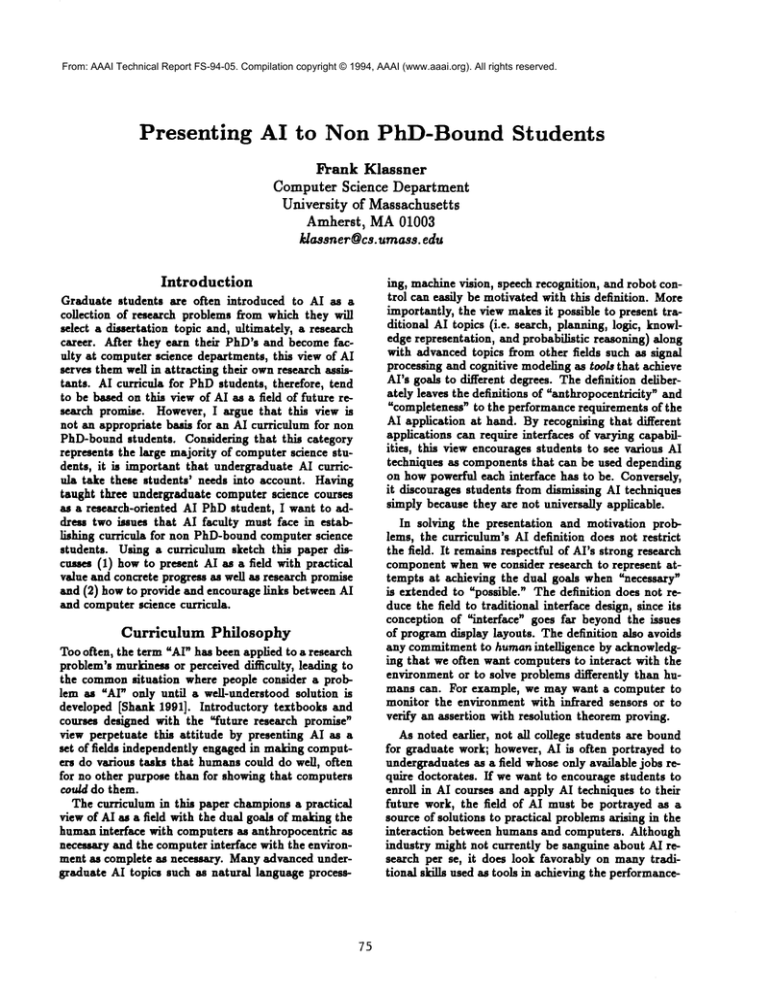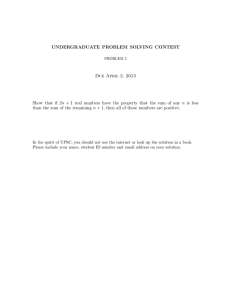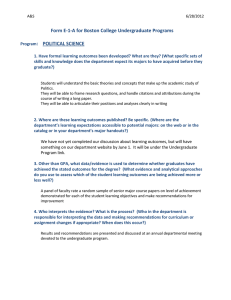
From: AAAI Technical Report FS-94-05. Compilation copyright © 1994, AAAI (www.aaai.org). All rights reserved.
Presenting
AI to Non PhD-Bound Students
Prank Klassner
Computer Science
Department
University
of Massachusetts
Amherst,
MA 01003
ldassner@cs, umass, edu
Introduction
in8, machinevision, speech recognition, and robot control can easily be motivated with this definition. More
importantly, the view makes it possible to present traditional AI topics (i.e. search, planning, logic, knowledge representation, and probabilistic reasoning) along
with advanced topics from other fields such as signal
processing and cognitive modeling as tools that achieve
AI’s goals to different degrees. The definition deliberately leaves the definitions of "anthropocentricity" and
"completeness" to the performance requirements of the
AI application at hand. By recognising that different
applications can require interfaces of varying capabilities, this view encourages students to see various AI
techniques as components that can be used depending
on how powerful each interface has to be. Conversely,
it discourages students from dismissing AI techniques
simply because they are not universally applicable.
In solving the presentation and motivation problems, the curriculum’s AI definition does not restrict
the field. It remains respectful of AI’s strong research
component when we consider research to represent attempts at achieving the dual goals when "necessary"
is extended to "possible." The definition does not reduce the field to traditional interface design, since its
conception of "interface" goes far beyond the issues
of program display layouts. The definition also avoids
any commitment to human intelligence by acknowledging that we often want computers to interact with the
environment or to solve problems differently than huroans can. For example, we may want a computer to
monitor the environment with infrared sensors or to
verify an assertion with resolution theorem proving.
As noted earlier, not all college students are bound
for graduate work; however, AI is often portrayed to
undergraduates as a field whose only available jobs require doctorates. If we want to encourage students to
enroll in AI courses and apply AI techniques to their
future work, the field of AI must be portrayed as a
source of solutions to practical problems arising in the
interaction between humans and computers. Although
industry might not currently be sanguine about AI research per se, it does look favorably on many traditional skills used as tools in achieving the performance-
Graduate students are often introduced to AI as a
collection of research problems from which they will
select a dissertation topic and, ultimately, a research
career. After they earn their PhD’s and become faculty at computer science departments, this view of AI
serves them well in attracting their ownresearch assistants. AI curricula for PhDstudents, therefore, tend
to be based on this view of AI as a field of future research promise. However, I argue that this view is
not an appropriate basis for an AI curriculum for non
PhD-bound students. Considering that this category
represents the large majority of computer science students, it is important that undergraduate AI curricula take these students’ needs into account. Having
taught three undergraduate computer science courses
as a research-oriented AI PhDstudent, I want to address two issues that AI faculty must face in establishing curricula for non PhD-boundcomputer science
students. Using a curriculum sketch this paper discusses (1) howto present AI as a field with practical
value and concrete progress as well as research promise
and (2) howto provide and encourage links between
and computer science curricula.
Curriculum
Philosophy
Too often, the term "AI" has been applied to a research
problem’s murkiness or perceived difficulty, leading to
the commonsituation where people consider a problem as "AI" only until a well-understood solution is
developed [Shank 1991]. Introductory textbooks and
courses designed with the "future research promise"
view perpetuate this attitude by presenting AI as a
set of fields independently engaged in mating computers do various tasks that humanscould do well, often
for no other purpose than for showing that computers
cou/d do them.
The curriculum in this paper champions a practical
view of AI as a field with the dual goals of makingthe
humaninterface with computers as anthropocentric as
necessary and the computer interface with the environment as complete as necessary. Manyadvanced undergraduate AI topics such as natural language process-
75
oriented AI interface goals: statistical reasoning, logic
analysk, signal processing, etc. Students who employ
AI techniques or use traditional slrilIR in nontraditional
ways to solve practical problems will make AI-fiavored
solutions more familiar and attractive to industry.
In an AI curr/culum emphaslfing practicality,
programrn[ng
must be an important component. Introductory courses without prograwming can leave students (especial/y those with little experience in programrnlng nontrivial projects) with a picture of AI as
amaglc programmins." Confrontations with combinatorially explosive search problems in programmingassignments make theoretical results in search complexity analysis more immediate to undergraduates who
are often still developing their owntheoretical reasoning capabilities.
Whi/e many undergraduates may not
be interested imtially in pursuing AI to the graduate
level, programmingassignments that bring some of the
experimental fun of AI down from the graduate level
can provide interesting enticements.
Curriculum
Content
I propose an AI curriculum with two courses and a
LISP programming laboratory. The first course is
an introductory course offered in conjunction with
the programming laboratory to second-semester juniors. The course would include a series of assignments following a progression from evaluating the behavior of complete software packages such as Macsyma
to modifying programs for performance improvements
to building a final project from scratch. The initial
behavior-evaluation assignments and progression in assignment complexity are important since the programming laboratory will require some lead time to orient
those students who have had no LISP experience. The
second course is an advanced-topics course offered to
first-semester seniors. It would rotate amongtopics
such as machinelearning, natural language processing,
and machine perception.
The debate over using LISP versus some other language for assignments is too involved to present here
completely. The curriculum outlined in this paper favors LISP because (1) its use would provide extended
experience in the functional programming paradigm,
(2) its support for list and type.inspedfic symbolseliminates the drudgery of re-implementing the support in
another language, and (3) its support for rapid prototyping makes experimental program modification assignments more feasible.
After an introduction to AI problems and evaluation, the first course wouldpresent the basic AI topics
of search, planning, and knowledgerepresentation during the first half of the semester and then repeat this
material in the second half with emphasis on the use
of probability, other evidential reasoning frameworks,
and logic techniques to control search and planning.
Continuing the curriculum’s emphasis on applied AI
tools, the advanced course’s first month would be a
76
tutorial in the advanced-topic’s applied slrill~ (e.g. applied signal processing for machine perception, linear
algebra for neural nets). In both courses, the curriculure’s AI definition gives the instructor the means to
present historically significant programsas examplesof
techniques for solving AI-related problems under various limiting circumstances (e.g. planning where subgoals don’t clobber other subgoals, or image processing
where scenes are high-contrast), rather than as failed
attempts at creating intelligence.
The advanced-topics course is intended to give students the opportunity to apply basic AI techniques extensively in a real problem domain and to glimpse the
domain’s research boundaries that might entice them
into graduate school. While the introductory course
would use problem instances from various AI subdiscipllnes such as natural language processing or gameplaying to motivate homeworkassignments, the advanced course’s dedication to one or two topics should
ensure that students leave with a feeling that AI’s subdisciplines are substantial. The topic rotation not only
allows instructors to periodically refresh their acquaintance with AI fields outside their immediate interests,
but also prevents the curriculum from degenerating
into a course sequence dealing exclusively with the instructor’s research forte.
Links with the Local Academic
Environment
At the undergraduate level it is important to ground
AI within the computer science discipline. Computers
and computation are, after all, central to the field’s
attempts at implementing entities that interact "intelligently" with humans and the environment. An undergraduate AI curriculum should therefore unhesitatingly point out and explain similarities between techniques and tools used in AI and various computer science fields. Such a grounding combines with programrning assignments to prevent students from developing
an "AI as magic programming" view. The curriculum
sketched here offers several possibilities for substantively ]inking AI with a computer science department’s
existing course of studies.
In many programming languages (PL) courses, the
functional programming paradigm is often presented
via a two- or three-week LISP tutorial. The LISP programmlng laboratory provides the opportunity for a
more comprehensive presentation of the paradigm. If
the department schedule does not permit an extra programminglaboratory, the AI curriculum could rely on
an extended treatment of LISP in the local PL course.
In either case, the AI curr/culum and the PL course
can reinforce each other.
Computer science undergraduate students often receive their only exposure to statistical
interpretat/on and probability theory in a third-year mathematics course that focuses on these topics’ formal
bases. By presenting evidential-reasoning
methods
Acknowledgments
from Bayesian theory and Dempster-Shafer theory as
tools for controlling search, the introductory AI course
can provide students with an example of how the theory behind probability and statistics can be used practical]y. If the department schedule requires the probability and statistics course in the fourth year, the department can still profit from the third-year introductory AI course as an applied introduction to the topics’
later formal treatment.
The majority of computer science curricula offer s
course in data structures and/or complexity analysis in
the second or third year. The introductory AI course,
through its emphasis on search, can serve as an excellent environment for reinforcing students’ understanding of 8raph-traversal algorithms. Lectures on the requirements of maintaining var/ous knowledge representations can give students a more intuitive grasp of complexity analysis techniques.
Finally, and perhaps most importantly, the AI curr/culum can serve as a bridge between central computer
science topics and outside fields. Durin8 questions a£ter his "Paper Tiger in a Cage" invited talk at the 1993
AAAIconference, Edward Feigenbanm lamented the
restricted range of computer applications traditionally
presented to undergraduate computer science students.
Because the advanced-topics course will present practical knowledgefrom fields such as biology, electrical
engineering, and psychology, it can broaden students’
capacity for applying their skills in ~nontraditional"
fields. In 1991 the ACM/IEEE-CSJoint Curriculum
Task Force [Turner 1991] recommended that undergraduate computer science programs provide approximutely 11 lecture hours on social, ethical, and professional issues. The advanced-topics course can provide
an excellent forum for the AI instructor and possibly
a guest lecturer from the local philosophy department
to address these issues.
I am grateful to Scott D. Anderson and Bruce A.
Draper for discussions that clarified myphilosophy for
teaching AI.
References
[Shank 1991] Shank, R. C., ~Where’s the AI?" AI
Magazine, vol. 12, no. 4, pp. 38-49, Winter 1991.
[Turner 1991] Turner, A J., "Computing Curricula
1991," Communications o/the ACM, vol. 34, no.
6, pp. 69-84, June 1991.
Conclusion
Faced with the less research-oriented futures of typical
undergraduate students, AI faculty must present their
field as being practical and progressive in addition to
being full of research promise. This problem takes on
special significance for AI’s future whenone considers
that while most undergraduate students probably will
not extend AI’s research in PhDdissertations, they all
have the potential to extend AI’s recognition in industry.
The curriculum sketched in this paper tries to solve
the practicality
problem by (I) presenting existing
AI techniques as tools for achieving various levels of
user/computer and computer/environment interaction
and (2) relating AI to other computer science topics.
At the same time, the curriculum’s advanced-topics
course remains respectful of AI’s strong research component by introducing students on a rotating basis to
selected subfields and their open issues.
77





